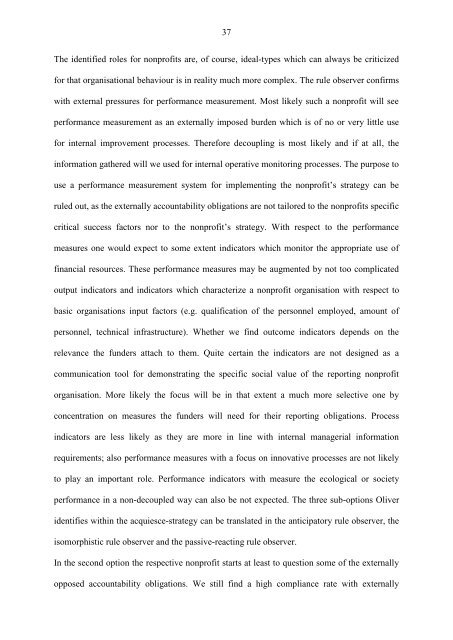Strategic responses to Performance Measurement in Nonprofit ...
Strategic responses to Performance Measurement in Nonprofit ...
Strategic responses to Performance Measurement in Nonprofit ...
Create successful ePaper yourself
Turn your PDF publications into a flip-book with our unique Google optimized e-Paper software.
37<br />
The identified roles for nonprofits are, of course, ideal-types which can always be criticized<br />
for that organisational behaviour is <strong>in</strong> reality much more complex. The rule observer confirms<br />
with external pressures for performance measurement. Most likely such a nonprofit will see<br />
performance measurement as an externally imposed burden which is of no or very little use<br />
for <strong>in</strong>ternal improvement processes. Therefore decoupl<strong>in</strong>g is most likely and if at all, the<br />
<strong>in</strong>formation gathered will we used for <strong>in</strong>ternal operative moni<strong>to</strong>r<strong>in</strong>g processes. The purpose <strong>to</strong><br />
use a performance measurement system for implement<strong>in</strong>g the nonprofit‟s strategy can be<br />
ruled out, as the externally accountability obligations are not tailored <strong>to</strong> the nonprofits specific<br />
critical success fac<strong>to</strong>rs nor <strong>to</strong> the nonprofit‟s strategy. With respect <strong>to</strong> the performance<br />
measures one would expect <strong>to</strong> some extent <strong>in</strong>dica<strong>to</strong>rs which moni<strong>to</strong>r the appropriate use of<br />
f<strong>in</strong>ancial resources. These performance measures may be augmented by not <strong>to</strong>o complicated<br />
output <strong>in</strong>dica<strong>to</strong>rs and <strong>in</strong>dica<strong>to</strong>rs which characterize a nonprofit organisation with respect <strong>to</strong><br />
basic organisations <strong>in</strong>put fac<strong>to</strong>rs (e.g. qualification of the personnel employed, amount of<br />
personnel, technical <strong>in</strong>frastructure). Whether we f<strong>in</strong>d outcome <strong>in</strong>dica<strong>to</strong>rs depends on the<br />
relevance the funders attach <strong>to</strong> them. Quite certa<strong>in</strong> the <strong>in</strong>dica<strong>to</strong>rs are not designed as a<br />
communication <strong>to</strong>ol for demonstrat<strong>in</strong>g the specific social value of the report<strong>in</strong>g nonprofit<br />
organisation. More likely the focus will be <strong>in</strong> that extent a much more selective one by<br />
concentration on measures the funders will need for their report<strong>in</strong>g obligations. Process<br />
<strong>in</strong>dica<strong>to</strong>rs are less likely as they are more <strong>in</strong> l<strong>in</strong>e with <strong>in</strong>ternal managerial <strong>in</strong>formation<br />
requirements; also performance measures with a focus on <strong>in</strong>novative processes are not likely<br />
<strong>to</strong> play an important role. <strong>Performance</strong> <strong>in</strong>dica<strong>to</strong>rs with measure the ecological or society<br />
performance <strong>in</strong> a non-decoupled way can also be not expected. The three sub-options Oliver<br />
identifies with<strong>in</strong> the acquiesce-strategy can be translated <strong>in</strong> the anticipa<strong>to</strong>ry rule observer, the<br />
isomorphistic rule observer and the passive-react<strong>in</strong>g rule observer.<br />
In the second option the respective nonprofit starts at least <strong>to</strong> question some of the externally<br />
opposed accountability obligations. We still f<strong>in</strong>d a high compliance rate with externally
















